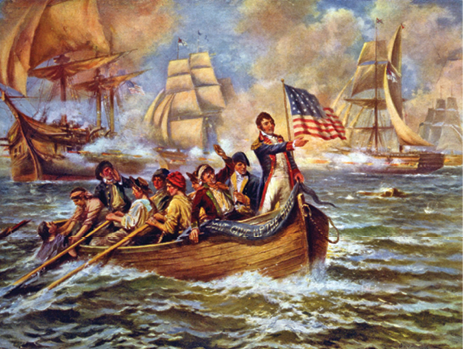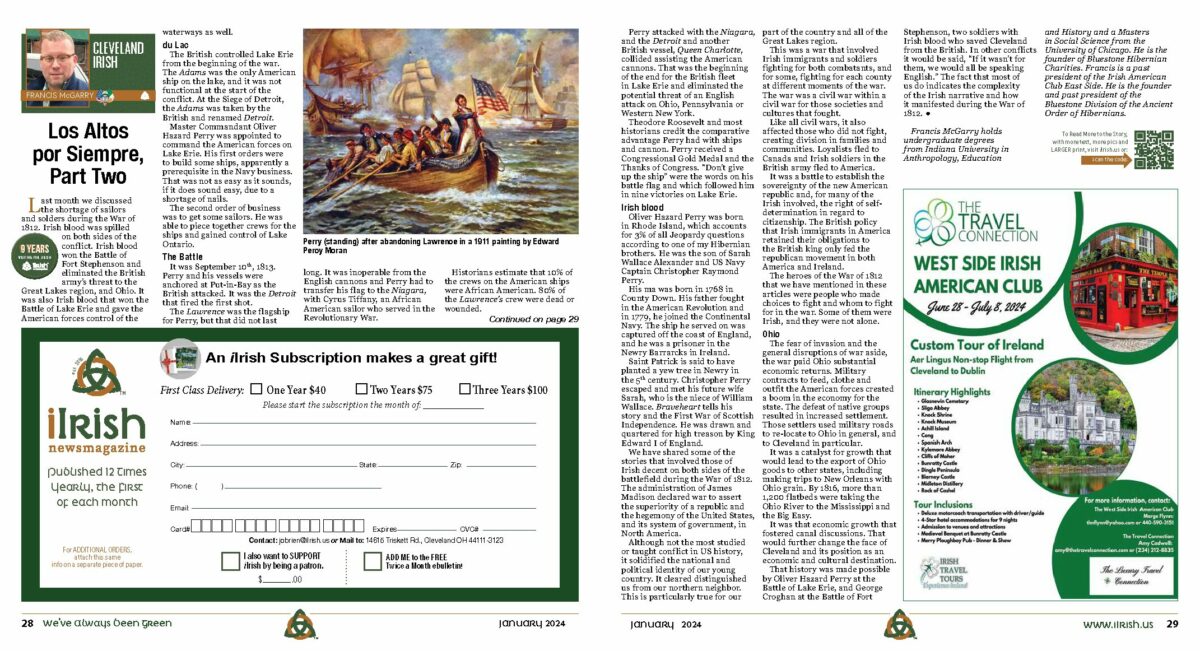
Last month we discussed the shortage of sailors and solders during the War of 1812. Irish blood was spilled on both sides of the conflict. Irish blood won the Battle of Fort Stephenson and eliminated the British army’s threat to the Great Lakes region, and Ohio. It was also Irish blood that won the Battle of Lake Erie and gave the American forces control of the waterways as well.
du Lac
The British controlled Lake Erie from the beginning of the war. The Adams was the only American ship on the lake, and it was not functional at the start of the conflict. At the Siege of Detroit, the Adams was taken by the British and renamed Detroit.
Master Commandant Oliver Hazard Perry was appointed to command the American forces on Lake Erie. His first orders were to build some ships, apparently a prerequisite in the Navy business. That was not as easy as it sounds, if it does sound easy, due to a shortage of nails.
The second order of business was to get some sailors. He was able to piece together crews for the ships and gained control of Lake Ontario.
The Battle
It was September 10th, 1813. Perry and his vessels were anchored at Put-in-Bay as the British attacked. It was the Detroit that fired the first shot.
The Lawrence was the flagship for Perry, but that did not last long. It was inoperable from the English cannons and Perry had to transfer his flag to the Niagara, with Cyrus Tiffany, an African American sailor who served in the Revolutionary War.
Historians estimate that 10% of the crews on the American ships were African American. 80% of the Lawrence’s crew were dead or wounded.
Perry attacked with the Niagara, and the Detroit and another British vessel, Queen Charlotte, collided assisting the American cannons. That was the beginning of the end for the British fleet in Lake Erie and eliminated the potential threat of an English attack on Ohio, Pennsylvania or Western New York.
Theodore Roosevelt and most historians credit the comparative advantage Perry had with ships and cannon. Perry received a Congressional Gold Medal and the Thanks of Congress. “Don’t give up the ship” were the words on his battle flag and which followed him in nine victories on Lake Erie.

Irish blood
Oliver Hazard Perry was born in Rhode Island, which accounts for 3% of all Jeopardy questions according to one of my Hibernian brothers. He was the son of Sarah Wallace Alexander and US Navy Captain Christopher Raymond Perry.
His ma was born in 1768 in County Down. His father fought in the American Revolution and in 1779, he joined the Continental Navy. The ship he served on was captured off the coast of England, and he was a prisoner in the Newry Barrarcks in Ireland.
Saint Patrick is said to have planted a yew tree in Newry in the 5th century. Christopher Perry escaped and met his future wife Sarah, who is the niece of William Wallace. Braveheart tells his story and the First War of Scottish Independence. He was drawn and quartered for high treason by King Edward I of England.
We have shared some of the stories that involved those of Irish decent on both sides of the battlefield during the War of 1812. The administration of James Madison declared war to assert the superiority of a republic and the hegemony of the United States, and its system of government, in North America.
Although not the most studied or taught conflict in US history, it solidified the national and political identity of our young country. It cleared distinguished us from our northern neighbor. This is particularly true for our part of the country and all of the Great Lakes region.
This was a war that involved Irish immigrants and soldiers fighting for both combatants, and for some, fighting for each county at different moments of the war. The war was a civil war within a civil war for those societies and cultures that fought.
Like all civil wars, it also affected those who did not fight, creating division in families and communities. Loyalists fled to Canada and Irish soldiers in the British army fled to America.
It was a battle to establish the sovereignty of the new American republic and, for many of the Irish involved, the right of self-determination in regard to citizenship. The British policy that Irish immigrants in America retained their obligations to the British king only fed the republican movement in both America and Ireland.
The heroes of the War of 1812 that we have mentioned in these articles were people who made choices to fight and whom to fight for in the war. Some of them were Irish, and they were not alone.
Ohio
The fear of invasion and the general disruptions of war aside, the war paid Ohio substantial economic returns. Military contracts to feed, clothe and outfit the American forces created a boom in the economy for the state. The defeat of native groups resulted in increased settlement. Those settlers used military roads to re-locate to Ohio in general, and to Cleveland in particular.
It was a catalyst for growth that would lead to the export of Ohio goods to other states, including making trips to New Orleans with Ohio grain. By 1816, more than 1,200 flatbeds were taking the Ohio River to the Mississippi and the Big Easy.
It was that economic growth that fostered canal discussions. That would further change the face of Cleveland and its position as an economic and cultural destination.
That history was made possible by Oliver Hazard Perry at the Battle of Lake Erie, and George Croghan at the Battle of Fort Stephenson, two soldiers with Irish blood who saved Cleveland from the British. In other conflicts it would be said, “If it wasn’t for them, we would all be speaking English.” The fact that most of us do indicates the complexity of the Irish narrative and how it manifested during the War of 1812.
Find this and Francis’s other Cleveland Irish columns and others from this month’s issue HERE!





*Francis McGarry holds undergraduate degrees from Indiana University in Anthropology, Education and History and a Masters in Social Science from the University of Chicago. He is the Executive Director of Bluestone Hibernian Charities and proprietor of McGarry Consulting. He is a past president of the Irish American Club East Side and the founder and past president of the Bluestone Division of the Ancient Order of Hibernians.

ends

Monthly newsmagazine serving people of Irish descent from Cleveland to Clearwater. We cover the movers, shakers & music makers each and every month.
Since our 2006 inception, iIrish has donated more than $376,000 to local and national charities.
GET UPDATES ON THE SERIOUS & THE SHENANIGANS!